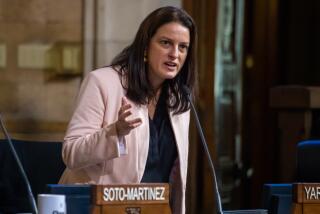ARTS PANEL HOPES TO GET $1 MILLION
With the deadline for submitting its revised grant application to the National Endowment for the Arts just days away, the California Arts Council now has “high hopes” that it will be awarded about $1 million in federal grants the second time around.
Harvey Stearn, vice chairman of the council and a senior vice president of the Mission Viejo Co., said he was told that final approval “looks excellent” after conversations in Washington with top endowment officials including Chairman Frank Hodsoll and public partnership director Anthony Turney.
Last February, for the first time in the council’s nearly 10 years of existence, the NEA, in a relatively rare procedure, rejected California’s application, saying that it “lacked vision and a clear sense of direction.” There was also criticism of “insufficient” ethnic programming. While the state agency was given a several-month grace period and an extra $15,000 from the endowment for a consultancy fee and planning meetings, the initial denial constituted a serious blow and fueled legislative disapproval.
The new and “considerably revised” application with certain sections “completely redone,” according to consultant James Backas, chairman of the Washington, D.C., arts council, must be postmarked no later than Friday. The endowment will review the changes in June. (Backas is receiving a $400-a-day fee.)
After adding an amendment requesting language that would provide for even more public input--one of the issues that had gotten the council into difficulty in the first place--the Arts Council unanimously voted Friday to approve the new document at a regular meeting at Caltech. There was concern, however, against making more changes. “Because of the NEA deadline, we have only a small window of opportunity,” chairman Stephen Goldstine cautioned.
The revised document is somewhat briefer--and smoother. Consider the preface: The old application woodenly begins: “California Arts Council programs are designed to meet the needs of the most populous (25 million residents) and one of the biggest of states: California’s coastline is 1,200 miles long.” The new application, which traces the state’s “successive waves of immigration” to the 1849 Gold Rush, begins: “It is difficult to describe the characteristics of California without resorting to excessive language. It is the most populous state in the country and the third largest in land mass, with 1,200 miles of coastline. . . .”
The changes are more than cosmetic. A crucial section on program development and evaluation has been expanded from three pages to nine.
On another key issue, the council voted to distribute $100,000 allocated for minority arts last July to 48 organizations which currently receive council grants. Supplements of about 25% were awarded, ranging from $5,368 to Galeria Plaza de la Raza to $1,000 to such organizations as the Young Saints Scholarship Foundation, a Los Angeles singing group.
The council put off until its May 24th meeting in San Francisco that old wrangle of public policy regarding what groups actually constitute a minority--beyond the current categories of blacks, Latinos, Asians, Pacific Islanders, American Indians and native Alaskans.
Calling the current definition “exclusive,” Patricia Geary Johnson of Rolling Hills, a watercolorist and an appointee of Gov. George Deukmejian, asked: “Why exclude Israelis, Latvians, Poles, Iranians, Lithuanians, Armenians, Egyptians, Turks, Greeks and the numerous other ethnic minority communities?”
Juan Carillo, an Arts Council program manager, noted that in some areas, a minority could mean Anglos.
As for the location of the council’s Southern California office, Goldstine said the council is “looking at” a satellite office in downtown Los Angeles, which would supplement the one in Van Nuys. Agency headquarters is in Sacramento. Marilyn Ryan, the council director, was making no promises, however. While she has received a number of offers of possible office space as a result of recent controversy over its location, she said, “I’m not committing myself to a specific alternative, which may be interpreted as a satellite office.”
More to Read
The biggest entertainment stories
Get our big stories about Hollywood, film, television, music, arts, culture and more right in your inbox as soon as they publish.
You may occasionally receive promotional content from the Los Angeles Times.










